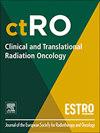优化儿科TBI双组分修复模型的预测准确性:儿科特异性参数、毒性终点协调和剂量率保障
IF 2.7
3区 医学
Q3 ONCOLOGY
引用次数: 0
摘要
针对儿科TBI肾毒性预测的创新双组分修复模型,本文提出了三个关键改进以增强临床翻译:采用儿科特异性放射生物学参数(例如DNA-PKcs动力学,α/β比率)来解决系统性高估辐射耐受性的问题;将毒性终点与CTCAE v5.0≥3级标准统一,以加强剂量反应关联并实现精确的风险分层;实施机构特定的最低剂量率阈值,以减轻低剂量率TBI期间未模拟的血管易感性。总的来说,这些优化将提高预测的准确性,并支持高危儿童队列的个性化放疗。本文章由计算机程序翻译,如有差异,请以英文原文为准。
Optimizing predictive accuracy of the two-component repair model for pediatric TBI: Pediatric-specific parameters, toxicity endpoint harmonization, and dose-rate safeguards
In response to the innovative two-component repair model for pediatric TBI renal toxicity prediction, this letter proposes three key refinements to enhance clinical translation: adopting pediatric-specific radiobiological parameters (e.g., DNA-PKcs dynamics, α/β ratios) to address systematic overestimation of radiation tolerance; harmonizing toxicity endpoints to CTCAE v5.0 ≥Grade 3 criteria to strengthen doseresponse associations and enable precise risk stratification; and implementing institution-specific minimum dose-rate thresholds to mitigate unmodeled vascular susceptibility during low-dose-rate TBI. Collectively, these optimizations will improve predictive accuracy and support personalized radiotherapy for high-risk pediatric cohorts.
求助全文
通过发布文献求助,成功后即可免费获取论文全文。
去求助
来源期刊

Clinical and Translational Radiation Oncology
Medicine-Radiology, Nuclear Medicine and Imaging
CiteScore
5.30
自引率
3.20%
发文量
114
审稿时长
40 days
 求助内容:
求助内容: 应助结果提醒方式:
应助结果提醒方式:


